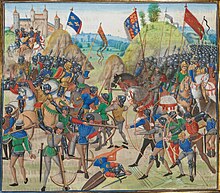

The Oriflamme (from Latin aurea flamma, "golden flame"), a pointed, blood-red banner flown from a gilded lance, was the sacred battle standard of the King of France and a symbol of divine intervention on the battlefield from God and Saint Denis in the Middle Ages. The oriflamme originated as the sacred banner of the Abbey of St. Denis,[1] a monastery near Paris. When the oriflamme was raised in battle by the French royalty during the Middle Ages, most notably during the Hundred Years' War, no prisoners were to be taken until it was lowered. Through that tactic, they hoped to strike fear into the hearts of the enemy, especially the nobles, who could usually expect to be taken alive for ransom during such military encounters.[2]
In French, the term oriflamme has come to mean any banner with pointed ends by association with the form of the original.
- ^ "Oriflamme Society". Archived from the original on 2005-10-28. Retrieved 2005-10-25.
- ^ Robert Southey (1841) Joan of Arc: a poem, Longman et autres. p. 280